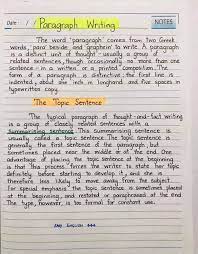A paragraph is a collection of related sentences about a unique topic. Learning to write good paragraphs as a writer will help you stay on track during your draft and revision modes. Good paragraphing also greatly helps your audience follow a piece of writing. You can have great ideas, but if those ideas aren't presented in an organized style, you'll lose your readers (and fail to achieve your writing goals).
Keep one idea to a paragraph
The basic rule of paragraphing is to keep one idea to one paragraph. If you start conveying a new idea, it belongs in a new paragraph. There are a few simple ways to tell if you are on a similar or new topic. You can have one idea and several pieces of supporting evidence in a single paragraph. You can also have multiple points in a single paragraph as long as they are related to the whole topic. If the individual points start to get long, then perhaps a detailed description of each one and putting them in their own paragraphs is the way to go.
Paragraph elements
To be as effective as possible, a paragraph should include any of the following: coherence, coherence, a title sentence, and adequate development. As you will see, all these features overlap. Using and selecting them for your unique purposes will help you create effective paragraphs.
Continuity
The entire paragraph should be about a focus unique to itself. If the discussion starts with one focus or main point, it should not end with another or deviate into different ideas.
coherence
Cohesion is a feature that makes a paragraph easy to understand for a reader. You can help create coherence in your paragraphs by creating logical bridges and verbal bridges.
Logical bridges
The same idea of a topic is transferred from one sentence to another
Consecutive sentences can be made into parallel forms
Verbal bridges
Keywords can be repeated in multiple sentences
Synonyms can be repeated in several sentences
Pronouns can refer to nouns in previous sentences
Transitional words can be used to connect ideas from different sentences.
A title sentence
A title sentence is a sentence that specifies in a general way what idea or proposition the paragraph will relate to. Although not all paragraphs have clear title sentences, and aside from the fact that title sentences can occur anywhere in a paragraph (as the first sentence, the last sentence, or somewhere in between), a simple way to make sure your reader is paragraph is understood is to place the title sentence near the beginning of the paragraph. (This is a good rule of thumb for less experienced writers, though it's not the only way to do it.) Regardless of whether or not you include a clear title sentence, you should be able to easily summarize what the paragraph is about.
Sufficient development
The title (which is introduced by the title sentence) should be fully and adequately discussed. Again, this varies from paragraph to paragraph, depending on the writer's purpose, but writers should be very wary of paragraphs that are only two or three sentences long. It is a very good bet that it will not be fully developed if it is so short.
Some ways to make sure your paragraph is well developed:
• Using examples and explanations (pictures)
• Referencing data (facts, statistics, evidence, details and others)
• Evidence testing (what other people said, such as quotes and interpretations)
• Use an anecdote or story
• Define phrases in paragraphs
• Compare and contrast
• Evaluation of causes and reasons
• Test effects and results
• Subject analysis
• Description of the subject
• Presenting the description of events in chronological order (time segments)
How do I know when to start a new paragraph?
You should start a new paragraph when:
• When you start a new idea or point. New ideas always start in new paragraphs. If you have an expanded idea that covers several paragraphs, each new point in that idea should have its own paragraph.
• To counter information or ideas. Separating paragraphs can be used for conflicting ideas in a discussion, different points in a discussion, or any other disagreement.
• When your readers need a break. Spaces between paragraphs act as a short break for your readers – adding them will help make your writing more readable. You will pause if the paragraph gets too long or the writing gets complicated.
• When you finish your introduction or start your conclusion. The introduction and conclusion should always be in a new paragraph. Many introductions and conclusions have several paragraphs depending on the content, length and purpose of the author.
 English
English Persian
Persian

